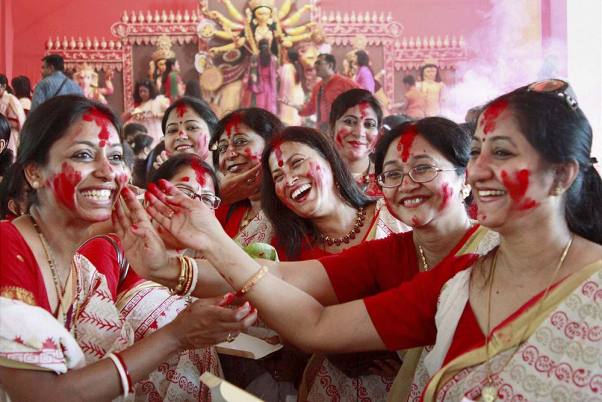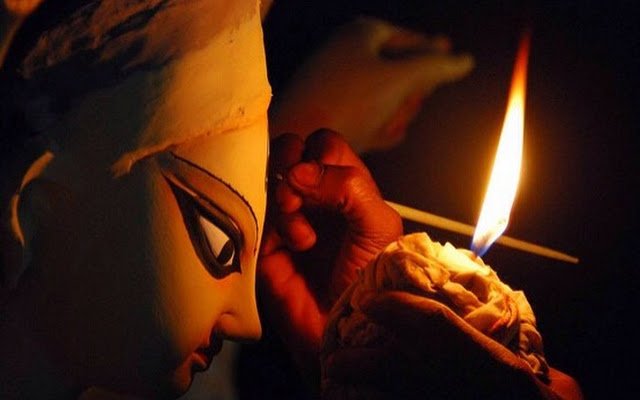History of Durga Puja
In recent years, a lot of scholarly attention has been turned towards explaining the non-Vedic roots of Goddess Durga. Kunal Chakraborty, one of the foremost historians to have worked on the subject has written that the accommodation of tribal deities into the Hindu pantheon through the Puranas, began from the 6th century onward.
It is only from the 16th century on that we see Durga developing into a Brahmanical deity, whose worship as a public festival gains visibility from the 18th century on.

Bengal and Durga Puja
The rise of the East India Company in Bengal was accompanied by the creation of a new urban space called Calcutta and the rise of a thriving mercantile class in the city, encouraged by the trade prospects there. The native merchants started working in close collaboration with the British as they were establishing themselves in the new city.
Durga Puja celebrations became the perfect means through which this newly formed mercantile class asserted its financial influence, not just to the natives, but also to the British and other Europeans.

One of the first instances of association between the nation and the Goddess is Bankimchandra’s celebrated novel, Anandmath, written in 1882, which made ‘Bande Mataram’ the most popular battle cry of nationalism. By the turn of the century, the Bengali press was loaded with a large number of patriotic songs and plays that drew upon the image of Durga in association with the nation.
What Durga Puja means for Bengalis ?
Today as Bengal, and the Bengali community all over the world celebrates Durga Puja in its familiar carnivalistic spirit, devoid of the usual religious sentiments attached to the worship of most other deities in India, it is important to keep in mind that the celebration of Durga, for generations has been far more than a spiritual and religious affair.

The Idols of Durga and her children is obviously the most important part of the grand event. Durga in her full avatar appears stabbing Mahishaura’s torso while riding the Lion. To her left stand Saraswati and Karthika and to her right, you will find Lakshmi, Ganesha, and Ganesha’s two wives in the form of two banana trunks. There would also be an image of Shiva above Durga. The whole structure or frame is called a Chala.
Chokkhudaan
One of the oldest and most interesting phenomenon is the Chokkhudaan or the offering the eye of Goddess Durga. Generally, it takes around 3 to 4 months to make a Durga Chala. The final stroke of the paint makes the eyes of Durga. This ritual is supposed to done in complete darkness and in the presence of only one sculptor and no one else. However, only a few sculptors follow this rule, as others have to finish the idol beforehand.

No Bengali misses the puspajanli or flower offering on Ashtami morning (eighth day of the festival). You can be anywhere in Kolkata in the morning of Ashtami and see how people, even strangers, come together and offer flowers to Goddess Durga, whom they consider as Maa or mother.
Forms of Goddess Durga
Goddess Durga is worshipped in many forms during the festival. One of the most famous forms being that of Kumari (virgin). A girl with a bright disposition and aged between one to sixteen years is selected beforehand. On the day of Ashtami, the Kumari girl is worshipped in front of the Durga idol. This ritual is considered as the purest form of worship. One of the most famous Kumari Pujas is the one that Swami Vivekananda started at Belur Math in Howrah that continues till date with grandeur.
Para Durga Puja
Durga Puja is not just about the pandals. Kolkata witnesses two separate kinds of Durga Puja and apart from the rituals, both are completely different from each other. One is the grand show of ‘para’ (locatlity) puja lights, designs, themes, ideas and crowd while ‘barir’ (home) puja, the other, has a homely effect and brings people closer to their roots with the sense of homecoming. The first kind happens in the pandals and community halls while the other inside the old houses of North Kolkata or the affluent households of South Kolkata.
Days of Durga Puja
The days of Durga Puja do not follow 12 to 12 clock system. One day changes to another in the evening. Every evening of Durga Puja is a grand festival itself. Drums, bells and brasses welcomes the new day with dance and especially, the dhunuchi naach. Sandhya Arati or the Evening Offering is an integral part of the rituals. The chant and incantations continue till next morning.
Dashami, a word that fills every Bengali heart with sadness, is the last day of Durga Puja. On this day, married women gather at the Puja pandals and smear each other with sindur (vermillion) much like playing with colours in Holi. This ritual marks the farewell of Goddess Durga.

The streets of Kolkata change on the last day of Durga Puja. Thousands of processions, millions of people throng the roads and the traffic gets into a tizzy. Goddess Durga bids adieu to her family and sets off for the Himalayas. The idols are immersed into the river, heads first. A ritual of family reunion takes place following the immersion. Every Bengali household hosts gatherings and exchange sweets and gifts with their loved ones.
@religionworldin
[video_ads]
[video_ads2]









